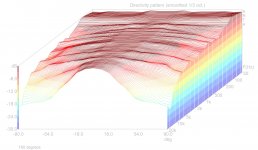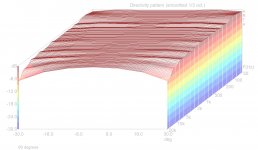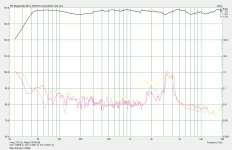Is the cuppy sound partly dependent on cone material?
Don’t know. Cone material likely does pay a role, its transmission capability key.
The speaker in question was a doped paper cone.
dave
"Aesthetics are surely a subjective issue, but big speakers can bean imposition and dominate a room. But ask yourself how you would feel if you had a pair of monitors the size of ping-pong balls which produced perfect sound. Disconcerting?"
I think it can be done...at least I am trying my best.....but our generation has the spirit of shrinking everything so, you can see how smaller speakers that supposedly "do the same thing" would take favor in the consumer market...followed by the sound engineering industry who are also chasing bucks....wow I just had yet another epiphany...the loudspeaker designers were chasing bucks by catering to the consumer....which is the first real decline in SQ.....the loudspeaker industry made more money by saving on materials for the smaller carbon foot print.....they started selling smaller loudspeakers to the mix/mastering engineers.....who only need "more" sound quality than the avg consumer as well as products that have similar characteristics as the average consumer play back system (polar?)....
Now watch this....the sound engineers can't fix what they can't hear....and the consumer all of a sudden want the mixes to produce these crazy dynamic levels.. with the tiny speakers....in compensation for the dynamic levels the consumer once got from truly dynamic performing loudspeaker systems of the past........
So that points the blame of the loudness war aaannnddd the low efficiency system on loudspeaker designers chasing money. The end. lmao! There is no circle of confusion, its just loudspeaker companies selling junk messing it up for everyone downstream....end of story. Calling it a circle of confusion is just a cop out for not taking responsibility for the mess you've made....
I think it can be done...at least I am trying my best.....but our generation has the spirit of shrinking everything so, you can see how smaller speakers that supposedly "do the same thing" would take favor in the consumer market...followed by the sound engineering industry who are also chasing bucks....wow I just had yet another epiphany...the loudspeaker designers were chasing bucks by catering to the consumer....which is the first real decline in SQ.....the loudspeaker industry made more money by saving on materials for the smaller carbon foot print.....they started selling smaller loudspeakers to the mix/mastering engineers.....who only need "more" sound quality than the avg consumer as well as products that have similar characteristics as the average consumer play back system (polar?)....
Now watch this....the sound engineers can't fix what they can't hear....and the consumer all of a sudden want the mixes to produce these crazy dynamic levels.. with the tiny speakers....in compensation for the dynamic levels the consumer once got from truly dynamic performing loudspeaker systems of the past........
So that points the blame of the loudness war aaannnddd the low efficiency system on loudspeaker designers chasing money. The end. lmao! There is no circle of confusion, its just loudspeaker companies selling junk messing it up for everyone downstream....end of story. Calling it a circle of confusion is just a cop out for not taking responsibility for the mess you've made....
Last edited:
No my Revel Performa F206's sound great!
Low efficiency speakers have been around forever 1954 AR acoustic suspension.
Rob🙂
So that points the blame of the loudness war aaannnddd the low efficiency system on loudspeaker designers chasing money.
Low efficiency speakers have been around forever 1954 AR acoustic suspension.
Rob🙂
I've been spending my days trying to figure out how to beautify a 32x17x32 box for a midrange
Vertical banding to break up its extra wide width to height ratio.
GM
I think this is the question. The first thing we probably imagine is the bass trying to escape, but I don't think this is the problem. Look at how small the basket cutouts are...What frequencies are reflected?
Planet10 does mention midrange colouration...
Woah. Just came back to read and the thread is fairly long. Just to clarify my OP thoughts were more what goes on inside a tight cabinet with a driver not having space around it, ie backwave cannot clear driver chassis easily and ends up reflecting off sides back into the cone
The smaller the better. If an enclosure is small compared to the highest frequency it is required to play, no standing waves can form. Tight is right.
Last edited:
Great stuff Vacuphile. Very clever design.
I've made few drawings with similar arangement but with woofers at the ends of the pipe, closed cabinet, dsp controlled, of course. Haven't moved this one from the drawing board though.
Do you have any measurements - on, off axis, waterfall, impedance ?
I'm guessing it is passive design.
It is an active design and it has been measured in the anechoic room of the Technical University in Delft. I will show some off axis measurements tomorrow, bedtime here.
Please do...awesome design!
The thought in the acoustical engineering shows.
Does it have a reflex port on top as well ?
The thought in the acoustical engineering shows.
Does it have a reflex port on top as well ?
No my Revel Performa F206's sound great!
Low efficiency speakers have been around forever 1954 AR acoustic suspension.
Rob🙂
Excuse me for my dramatization lol
So that points the blame of the loudness war aaannnddd the low efficiency system on loudspeaker designers chasing money. The end. lmao! There is no circle of confusion, its just loudspeaker companies selling junk messing it up for everyone downstream....end of story. Calling it a circle of confusion is just a cop out for not taking responsibility for the mess you've made....
I really think not. The leading cause of a decline in serious SQ for the public is that music does not have the primacy it had say, in the 70s, this being that the then zeitgeist contained exciting political thinking. Music became corporatised from about the mid 80s, said little, and was 'chewing gum'.
So why would the public then want really good high resolution sound systems when the music was vacuous junk? (PWLtd)
Hence they didn't want serious systems, and bought smaller ones, two 'bricks' either side of a plastic 9" cube with tuner CD and amp. The manufacturers, as always, then followed public demand to make money.
Last edited by a moderator:
So why would the public then want really good high resolution sound systems when the music was vacuous junk? (PWLtd)
Speaking as a teenager in the late 80's there was plenty of decent music that would be nice to listen to on a decent system. I was into rock at that time so buying plenty of 70's stuff as well as contemporary. Plenty of electronic music too that a good system would make 'more pleasant' to listen to.
As always the 'anoraks' (us 😀 ) make up a very small part of the target market, so cheap crappy systems will be good enough for the majority of people. (I know people who are happy to watch films on their phones. I'm waiting until I get my projector set up again before I watch any more films)
Most of the time the majority don't really care as long as the technology works 'ok'
Cheers,
Rob
Excuse me for my dramatization lol
Hello Camplo
The point is low efficiency speakers were popular and around decades before the loudness wars They did not result from or contribute to it. Everyone seems to forget how popular Radio Shack and Lafayette speakers were as well as many other cheap Japanese Kabuki speakers back then. Wasn't all Klipsh Jensen KLH AR EV JBL or Altec. There was plenty of crap to go around just like today.
Rob🙂
Check out the lyrics from Public Enemy's Bring the Noise circa 1988
The politics of the song is about racism and how rap is treated compared to rock-n-roll against the backdrop of how black citizens are treated by the police. That sounds political to my ear.
So if political relevance = consumer desire for sound quality we should look to systems built by late 80s young black urban Americans.
The cool thing is that with streaming audio services you can pull up music like this and play it on your good systems. To my shame, I'd never buy rap music. But I'll definitely pull it up on a streaming service and play it to learn about rap.
btw, all-you-can-eat audio streaming services are one heck of an industry innovation.
Soul control, beat is the father of your rock'n'roll
Music for whatcha, for whichin', you call a band, man
Making a music, abuse it, but you can't do it, ya know
You call 'em demos, (but we ride limos, too)
Whatcha gonna do? Rap is not afraid of you
Beat is for Sonny Bono, (Beat is for Yoko Ono)
Run-DMC first said a DJ could be a band
The politics of the song is about racism and how rap is treated compared to rock-n-roll against the backdrop of how black citizens are treated by the police. That sounds political to my ear.
So if political relevance = consumer desire for sound quality we should look to systems built by late 80s young black urban Americans.
The cool thing is that with streaming audio services you can pull up music like this and play it on your good systems. To my shame, I'd never buy rap music. But I'll definitely pull it up on a streaming service and play it to learn about rap.
btw, all-you-can-eat audio streaming services are one heck of an industry innovation.
The smaller the better. If an enclosure is small compared to the highest frequency it is required to play, no standing waves can form. Tight is right.
Hadnt thought of it like that.
I guess for a 3 was mid that works v well.
The first thing we probably imagine is the bass trying to escape, but I don't think this is the problem. Look at how small the basket cutouts are....
What is the problem then? Has not lower frequencies longer wavelengths and by that a lot easier to escape traps?
The narrow box isn't a problem of restriction, and it doesn't get smaller as the sound leaves the cone. Besides, sound can travel down a pipe without seeing a restriction per se.
But the longer wavelengths can make it through this bendy path starting at the back of the cone and out into the box, all inside part of a wavelength. So the shape isn't a problem either.
But the longer wavelengths can make it through this bendy path starting at the back of the cone and out into the box, all inside part of a wavelength. So the shape isn't a problem either.
OK, so with regard to quality systems and music, there was undoubtedly good stuff throughout the 80s and even into the 90s, but much less so in mainstream pop IMO, and mainstream is where volume sales are made both in music and sound systems.
I doubt that Kylie's "I Should be so Lucky" or Rick Astley's "Never Going to Give you up" would prompt anyone to buy a serious sound system. (Although even these cannot be said to be completely free of politics).
We, as you say, 'anoraks', are probably so about both higher quality art, devotees, and also to good reproduction to maximise the experience; often higher quality art merits such.
People come to my place who are not audiophiles, and their moths drop when they hear what I have.
I doubt that Kylie's "I Should be so Lucky" or Rick Astley's "Never Going to Give you up" would prompt anyone to buy a serious sound system. (Although even these cannot be said to be completely free of politics).
We, as you say, 'anoraks', are probably so about both higher quality art, devotees, and also to good reproduction to maximise the experience; often higher quality art merits such.
People come to my place who are not audiophiles, and their moths drop when they hear what I have.
As promissed some measurements from my impaled R2D2's, but first some explanation. These measurements are from a slightly smaller version than the black/white model I showed. It has an analog active three way xover. In other words, there are no dsp corrections made on the frequency response. With DSP, it is easy to get the frequency response straight as a ruler.
As I mentioned, the design goal is to get as much a point source for all frequencies, but there is a caveat. A true omni speaker (point source) would have a straight power response and that is not what we want. The power response should show a gradual down slope. This is what happens with my speaker as is shown below.

This measurement is 90 degrees both ways, so it shows a 180 degree view. Please compare with similar measurements made by Stereophile. The only one I found comparable, but slightly worse, is that of the Magico M2.
The following shows what happens inside a +/- 30 degrees listening window.

There is no noticable audible difference within this window. Toe in or toe out, just becomes irrelevant.
The last measurement shows distortion at a very loud level, just under 100dB/meter. As you can see, the tweeter starts falling apart, but the bass distortion is examplary even at this level. It also shows that the frequency response is +/- 2 dB or less, as I mentioned, without DSP trickery. This indicates the absence of diffraction artifacts.

I tested these speakers at the same time I was doing an article with Jan Didden on the Kii, both in the anechoic room and in listening tests. The Kii is a very, very good speaker. Mine just sound and measure better.
As I mentioned, I started to sell these speakers on demand, and after we all have had our vaccinations, my listening room in The Hague will be open to all.
As I mentioned, the design goal is to get as much a point source for all frequencies, but there is a caveat. A true omni speaker (point source) would have a straight power response and that is not what we want. The power response should show a gradual down slope. This is what happens with my speaker as is shown below.

This measurement is 90 degrees both ways, so it shows a 180 degree view. Please compare with similar measurements made by Stereophile. The only one I found comparable, but slightly worse, is that of the Magico M2.
The following shows what happens inside a +/- 30 degrees listening window.

There is no noticable audible difference within this window. Toe in or toe out, just becomes irrelevant.
The last measurement shows distortion at a very loud level, just under 100dB/meter. As you can see, the tweeter starts falling apart, but the bass distortion is examplary even at this level. It also shows that the frequency response is +/- 2 dB or less, as I mentioned, without DSP trickery. This indicates the absence of diffraction artifacts.

I tested these speakers at the same time I was doing an article with Jan Didden on the Kii, both in the anechoic room and in listening tests. The Kii is a very, very good speaker. Mine just sound and measure better.
As I mentioned, I started to sell these speakers on demand, and after we all have had our vaccinations, my listening room in The Hague will be open to all.
Last edited:
At a first glance the measurements look very good indeed.
For the sake of clear comparisons, could we please see a Sonogram, both horizontal and vertical, and as per icing of the cake, normalized and non- normalized?
For the sake of clear comparisons, could we please see a Sonogram, both horizontal and vertical, and as per icing of the cake, normalized and non- normalized?
The narrow box isn't a problem of restriction, and it doesn't get smaller as the sound leaves the cone. Besides, sound can travel down a pipe without seeing a restriction per se.
But the longer wavelengths can make it through this bendy path starting at the back of the cone and out into the box, all inside part of a wavelength. So the shape isn't a problem either.
Thank you, i had misunderstanded you, now i see your point 🙂
- Home
- Loudspeakers
- Multi-Way
- Are modern narrow baffle designs inherently flawed?